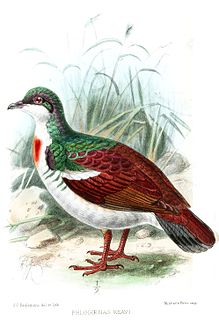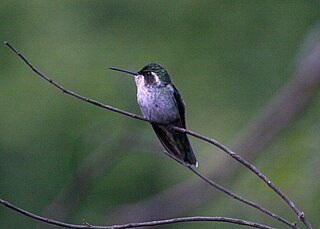
The Negros bleeding-heart pigeon is endemic to the Philippines where it is found on the islands of Negros and Panay. It is critically endangered; continuing rates of forest loss on the two islands where it occurs suggest that it will continue to decline. The population is estimated to be just 50 - 249 mature individuals. The species has an extremely small, severely fragmented population. The bird is listed as an EDGE species under the analysis of the Zoological Society of London.

The Isabela oriole is a species of the oriole family endemic to Luzon in the Philippines. The bird was presumed to be extinct for many years until its rediscovery in December 1993 near Diffun, Quirino, and in Mansarong in September 1994. Additional sightings were made in San Mariano, Isabela. and Baggao, Cagayan Valley It It is found in moist lowland forest up to 440 masl. It is threatened by habitat loss and hunting.

The Taita falcon is a small falcon found in central and eastern Africa. It was first described from the Taita Hills of Kenya from which it derives its name.
The Taita thrush, also known as the Taita olive thrush or Heller's ground thrush, is an endangered bird from the family of thrushes (Turdidae), endemic to the Taita Hills in Kenya.

The Taita Hills, sometimes also spelled as Teita Hills, are a mountain range located in the Taita-Taveta County in south-eastern Kenya. The hills consist of three massifs: Dawida, Sagalla in the southern side of Voi township and Kasigau in the south near the border of Tanzania. The Dawida massif is the largest and tallest of the three, with an altitude of 2,228 metres (7,310 ft) above sea level at its highest peak, Vuria. Dabida has three other main peaks: Iyale, Wesu, and Susu.

Ngangao Forest is one of the few remaining indigenous cloud forest fragments of the Taita Hills, Kenya. It is located on a rock surrounded by the villages of Makandenyi, Maghimbinyi, Mgambonyi and Kitumbi. It lies 10 km from Wundanyi and can easily be reached by road. There is even frequent public transport from Wundanyi to Makandenyi. The very basic "Ngangao forest camp" is located next to the forester's house at the edge of forest.
The Namuli apalis is a small African passerine bird belonging to the genus Apalis in the family Cisticolidae. It was formerly considered as a subspecies of the bar-throated apalis.

The bar-throated apalis is a small African passerine bird belonging to the genus Apalis of the family Cisticolidae. It is native to the eastern and southern Afrotropics.

The apalises are small passerine birds belonging to the genus Apalis, in the family Cisticolidae. They are found in forest, woodlands and scrub across most parts of sub-Saharan Africa. They are slender birds with long tails and have a slender bill for catching insects. They are typically brown, grey or green above and several species have brightly coloured underparts. Males and females are usually similar in appearance but the males are sometimes brighter.

The green-breasted mountaingem or green-breasted mountain-gem is a species of hummingbird in tribe Lampornithini of subfamily Trochilinae. It is found in Honduras and Nicaragua.
The orange-necked partridge is a species of bird in the family Phasianidae. It is found in eastern Cambodia and southern Vietnam. Its habitats are lowland forests, shrubland, and plantations. It was described in 1927 and rediscovered in 1991. It is threatened by habitat loss, and the International Union for Conservation of Nature (IUCN) has assessed it as a near-threatened species.

The cryptic forest falcon is a species of bird of prey in the family Falconidae. It is found in the south-eastern Amazon rainforest in Brazil and Bolivia. While uncommon in its Amazonian range, it remains widespread, and is therefore rated as least concern by BirdLife International and IUCN. Unlike the lined forest falcon, with which it has long been confused in a cryptic species complex, adult cryptic forest falcons only have a single white tail-band.

Hombron's kingfisher or the blue-capped kingfisher is a species of bird in the family Alcedinidae endemic to the Philippines and found only on Mindanao. It is one of the most colorful kingfishers in the country having a dark blue cap and wings with rufous spots, a striped rufous belly, white chin and red bill. Its natural habitats are on the upper ranges of tropical moist lowland forest and tropical moist montane forests. It is threatened by habitat loss.

The yellow-throated apalis is a passerine bird in the family Cisticolidae. It is endemic to Malawi. It was sometimes considered it to be a subspecies of the bar-throated apalis.

Boucard's wren is a species of bird in the family Troglodytidae. It is endemic to Mexico.
The Biak monarch, or Biak monarch flycatcher, is a species of bird in the family Monarchidae. It is endemic to Biak Island, Indonesia.

The eared pitta is a species of bird in the pitta family, Pittidae, and is found in Southeast Asia.

The Sulu pygmy woodpecker, also known as the Sulu woodpecker, is a species of bird in the family Picidae. Formerly lumped with the Philippine pygmy woodpecker, it seems to form a superspecies with this and the Sulawesi pygmy woodpecker. Some taxonomic authorities continue to place this species in the genus Dendrocopos or Picoides.

The Hispaniolan trogon is a species of bird in the family Trogonidae. It is endemic to Hispaniola in the Caribbean. It is one of the only two trogon species found in the Caribbean. It is the national bird of Haiti.
The Cebu boobook or Cebu hawk-owl is a species of owl in the family Strigidae. It is endemic to the Philippines. It was formerly considered a subspecies of the Philippine hawk-owl, but was reclassified in 2012, as voice and other data suggested placement in a distinct species.















